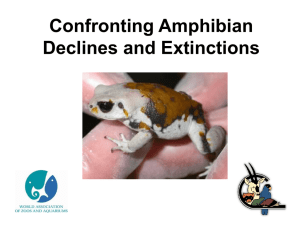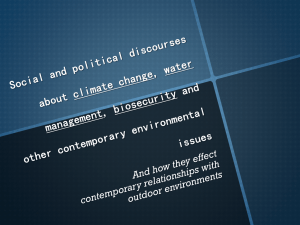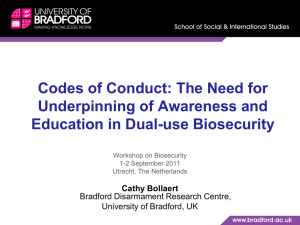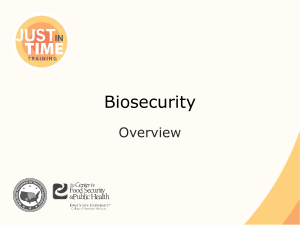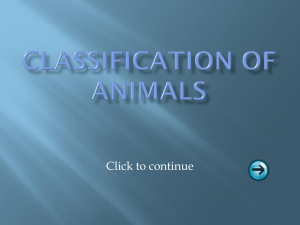Biosecurity sept 08 (Richard Gibson)
advertisement
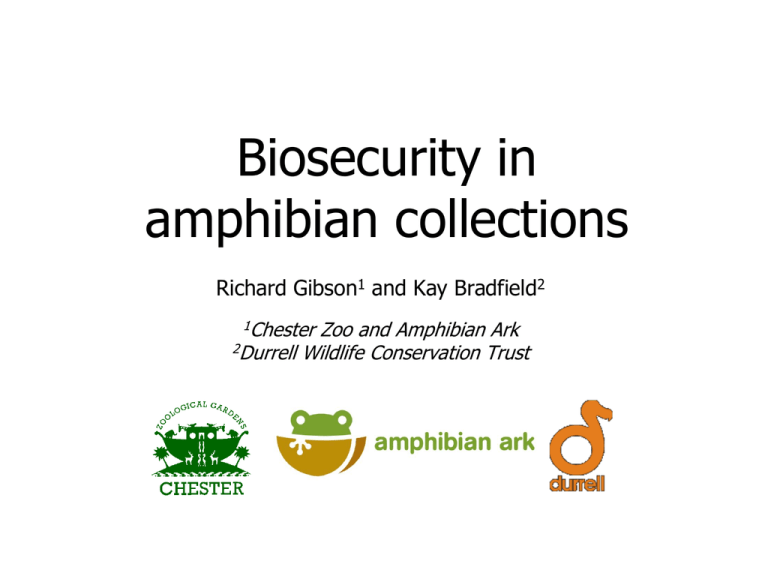
Biosecurity in amphibian collections Richard Gibson1 and Kay Bradfield2 1Chester Zoo and Amphibian Ark 2Durrell Wildlife Conservation Trust The problem Perhaps 500 species of threatened amphibian require ex-situ conservation, including intensively managed captive populations to produce animals for potential release back into the wild. Amphibian chytrid • Batrachochytrium dendrobatidis – B.d. • associated with amphibian die-offs on every continent (genetically uniform) • unstoppable & untreatable in the wild • “the worst infectious disease ever recorded among vertebrates in terms of the number of species impacted, and its propensity to drive them to extinction.” Because chytrid fungus is a major threat to most amphibian species, protocols for managing amphibians ex situ must be modified to take account of the need for enhanced quarantine and hygiene. Furthermore, amphibian Ark/Rescue/Supplementation populations must be maintained as pure and ‘wild’ as possible in order to be able to return them to their natural habitats in the future. Facilities for maintaining amphibian colonies of this nature must therefore be ‘biosecure’. What does ‘biosecurity’ really mean? • Biosecurity - the protection of the environment and its native species from exotic pathogens • Biosecurity & ex-situ conservation facilities – need to protect captive spp. from pathogens present in the external environment (whether facility is in-range or out-of-range) – need to protect native spp. in external environment from pathogens carried by captive spp. (if captive spp. are being held out-of-range) How do we achieve biosecurity? BIOSECURITY = RISK ASSESSMENT + RISK MINIMISATION Risks are minimised through erecting and maintaining appropriate barriers and routines. • Multi-species facilities that house a geographically diverse range of spp. or that are located outside the range of species held, pose the greatest risks • For conservation programmes you should retain pathogens the species is exposed to in the wild, but exclude others the only way to do this is total quarantine and isolation of projects, otherwise you should not release animals into the wild. The most successful amphibian conservation programme to date? Amphibian biosecurity is not just about B. dendrobatidis • There are numerous amphibian diseases we already know about – what about the ones we haven’t discovered yet? • At least some of these will have had a long evolutionary history as amphibian generalists, meaning that they may infect other amphibian spp. • As the natural host species are unlikely to exhibit signs of infection, traditional quarantine measures (e.g. 30 – 90 day holding periods, health screening) will not detect these pathogens. Considerations for designing & developing biosecure facilities • Level of biosecurity required – purpose of animals – in-range vs. out-of-range • Pathogen transfer/movement – air? – water – substrates/live plants/‘furniture’/equipment – wastes – food animals (and their food) – pests – the animals themselves – people Considerations for designing & developing biosecure facilities cont… • Treatment /disposal of waste from facility – Water e.g. holding tanks & chlorine injection – other waste (faeces, substrates, ‘furniture’, equipment, uneaten food, gloves, disposable gowns, etc.) e.g. double bag as clinical waste & incinerate Considerations for developing biosecure & quarantine working protocols • Restrict access to essential staff only • Staff must be trustworthy & reliable • Minimise keeper access to biosecure facilities & enclosures within them – every time a facility / enclosure is accessed there is the potential for biosecurity to be breached minimising keeper access allows greater isolation (and therefore protection) of animals Considerations for developing biosecure / quarantine working protocols cont… • Protective clothing – footwear • dedicated boots – gowns/overalls • disposable vs. washable – gloves • must be worn with all amphibians at all times! • put on/remove in a sterile fashion! • Dedicated instruments/equipment for each enclosure/species Considerations for developing biosecure / quarantine working protocols cont… • Always follow the same service order - rooms/buildings - within rooms/buildings • Disinfection of equipment & enclosures - disinfectant(s) used - concentration & contact time - need to remove organic matter • Maximise automation - spray systems - filtration systems - food funnels The AArk’s role is to help the zoo/aquarium community save as many amphibian species as possible by: • • • • • • Providing global coordination Technical guidance Training Linkage to other IUCN groups Communications Guiding publicity and capital campaigns Basic Specimens maintained ex situ for Educational* purposes with no requirement for research and no prospect of release to the wild. BIOSECURITY Separate footwear per room and/or footbaths at entry/exit. Treatment/decontamination of all waste water from enclosures and rooms housing amphibians prior to discharge/disposal (addition of household bleach at ratio 1:10 by volume). Incineration (or disinfection by means of suitable chemicals, heating to 70°C for 25mins, or complete desiccation) of all amphibian enclosure waste – soil, leaves, plants, furnishings, food items, faeces, bodies (after post-mortem examination). Escape-proof housing of a size appropriate for species. Pest-proof housing (rodents, cockroaches, ants, etc) to prevent pathogen transfer, predation of amphibians, and escape of food insects. Water free of pathogens and chemical contaminants. HUSBANDRY Regular water changes – automated or manual. Appropriate cage furnishings wherever necessary. Exposure to natural light (or good artificial equivalent) if exposure is normal in natural history of the species. Appropriate temperature/humidity for natural history of the species. Appropriate food, dependent on species – with supplementation (vitamin/mineral). Intermediate Specimens maintained ex situ for Conservation Research* purposes with no prospect of release to the wild. All Basic standards, but also: BIOSECURITY Individual instruments (tongs, nets, bowls, tanks, pumps, filters etc) per enclosure and/or species. Change gloves (non-powdered) for each enclosure. Design of enclosure should minimize keeper/animal contact. Maximize use of automation in water quality maintenance/watering. Maintain a consistent/directional flow of husbandry routine – from low risk and high importance species/individuals to high risk and lower importance species/individuals. HUSBANDRY Climatic conditions (lighting, photoperiod, temperature, rainfall, humidity, etc) should follow the natural cycle for the species and be automated wherever possible. Highest level of record-keeping. Advanced Specimens maintained ex situ for conservation breeding purposes (Ark/Rescue/Supplementation)* with the ultimate expectation of release to the wild. All Basic and Intermediate standards, but also: BIOSECURITY One species or local assemblage of species per room/unit – a state of permanent quarantine. Separate uniforms/overalls per room (stays in room unless disposable). Food coming from known and trusted source; 3-month period of familiarization with natural food types recommended prior to any release. Pre-release, monitor condition of specimens to determine fitness for release – thorough health screening including; regular and frequent PCR screening for chytrid fungus over several months; screening for Ranavirus; regular bacteriological and parasitological screening; and thorough necropsy and histological examination of deceased animals and a representative subset of the intended release animals – see Pessier, A. P. (In press): Management of disease as a threat to amphibian conservation. International Zoo Yearbook, 42, for a comprehensive overview of amphibian health screening needs. Room 2 (north side) A re-discovered Costa Rican highland species The future green-eyed frog Lithobates vibicaria Training ACH – Jersey, 2008 • Amphibian Conservation Husbandry 2008 (ACH) • Duration: 11 days • Participants: 21 ex-situ amphibian conservationists from 11 European countries • Course content: Module 1: Amphibian biodiversity and change Module 2: Captive facility design and construction Module 3: Breeding and managing populations Module 4: Managing animal health in captivity Measuring UV light from different light sources Spawned by the ACH • • • • • Thoiry, France – March 2009 Barcelona, Spain – Feb 2009 Reaseheath, UK – 2009 Nordens Ark, Sweden, Feb 2009 Rotterdam/Antwerp/Amsterdam, Netherlands/Belgium – Nov 2008 • Riga, Latvia (incl Russian zoos) – Oct 2008 • Zoo/private, Germany – Nov 2008 • Lisbon, Portugal – June 2008 Biosecurity & ‘educational’ animals While we may not be (as) worried about transmitting pathogens to animals held purely for educational purposes, we do need to be concerned about the possibility of transmitting pathogens from these animals to the local environment – gloves – footwear/footbaths – treatment of waste water – incineration of other waste What about… • • • • • • Universities Laboratories Schools Pet shops Pet keepers Frog farms AARK plans to write Basic Biosecurity for Amphibian Keepers document for dispersal to these sectors of the amphibian-keeping community What about?
